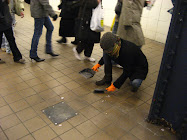Hayley,
I'm also interested in "depressed" areas, and how neighborhoods get classified, and by whom.
This is largely because the very neighborhood I grew up in has in recent years transformed into Chelsea: artworld neighborhood of the East Coast. However, when I was a kid it was just where middle class folks like me lived because it was cheap and was close to the Village.
It wasn't exactly "cool" to live there, but it had everything one could need as a middle class family: good food shopping, theatre, parks for kids, etc. It was in close proximity to the river, which unfortunately at that time was also "depressed" (cover-up word for predominantly gay and lesbian and "other": middle to lower middle class...) It wasn't paradise, and there were many mean kids that swarmed the streets, but it was all I knew. My parents still live there, but it's a golden cage...
I'm saddened that the center middle class of New York City has largely been moved to the perimeter of the outer boroughs...makes me think of the vague comparison of District Six in Cape Town...no forced removals here, but the insidious incline of rent and cost of living has forced outward thousands of families that can no longer afford to live in Manhattan, let alone many parts of Brooklyn that have been "gentrified" or consumed by Manhattan Overflow.
...when I spoke to the CBS advertising guy about pricing for subway panels, the rates for advertising in "non-prime" (why didn't he just say 'non-rich/white/in the center' ?) areas were cut by more than half. He spoke without irony, all business.
I'd like to explore the use of panels in areas deemed undesirable. Like Women's work, much of the labor done outside the center is also under or unvalued. What could it mean to bring those aspects into the public? Who would see them? What difference could it make? How could we intervene in the space to intervene?
Monday, April 14, 2008
Subscribe to:
Post Comments (Atom)



No comments:
Post a Comment